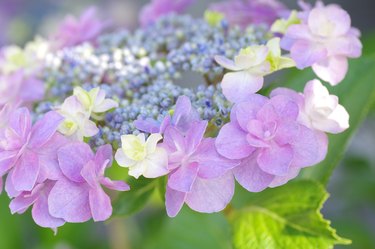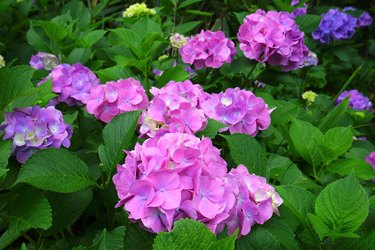
Hydrangeas (Hydrangea spp.) are one of more than 200 plant species that can become infested with spider mites, which are tiny arachnids that suck moisture out of the plants' leaves. When it comes to treating spider mites on hydrangeas, nonchemical methods are recommended over insecticides, which can wipe out the beneficial insects that keep spider mites in check and therefore make the problem even worse. In fact, spider mite outbreaks often occur after the use of such insecticides.
Spider Mite Identification
Video of the Day
Spider mites measure a mere 1/50th of an inch, which makes them extremely difficult to spot with the naked eye. You may realize that your hydrangeas are infested thanks to the webs the spider mites weave between the leaves, hence their name. Spider mites typically form colonies on the underside of leaves, where their specialized mouth organs allow them to extract sap. As a result of this feeding, the leaves of an infected hydrangea plant may appear freckled.
Video of the Day
Spider mites thrive when the weather is hot and dry. When temperatures exceed 90 degrees Fahrenheit, their numbers can grow very quickly. In hot weather, it is recommended that you inspect your garden plants for spider mites every three to five days using a magnifying glass so that you can detect these tiny pests. Note that spider mite eggs are capable of overwintering on plant debris.
Eradicating Spider Mites on Hydrangeas

One way to remove spider mites on hydrangeas is to wash them off the leaves with a stream of water. This also eliminates their webs. Since spider mites are more active during dry, hot weather, keeping hydrangeas well-watered during such periods is crucial. This means watering hydrangeas at least once a week. Applying mulch can also help the plants to conserve moisture.
Insecticides that leave a residue, such as bifenthrin and permethrin, will certainly kill spider mites. However, using them is counterproductive, as these chemicals also kill the beneficial insects that prey on spider mites, such as lady bugs and predatory mites. Therefore, if you must resort to chemical control, it is recommended that you use horticultural oils or insecticidal soaps, which have minimal effect on the beneficial insects. Note that these products must come in direct contact with spider mites in order to be effective.
Other Hydrangea Pests
In addition to spider mites, hydrangeas can become infested with aphids, which are small insects that also suck moisture from succulent plant parts. Like spider mites, aphids gather on the underside of the leaves. As with spider mites, you can control aphids by dislodging them with water from a hose or by applying insecticidal soap.

Other hydrangea pests include the black vine weevil, the larvae of which feed on the roots of hydrangeas, which can eventually kill the plants. These insects can be controlled by applying parasitic nematodes, which are a type of roundworm, to the soil. Hydrangeas can also fall victim to the four-lined plant bug and the tarnished plant bug. However, the damage caused by these bugs rarely calls for control.